Possibly the most iconic of all Australian desserts, the perfect pavlova is one I grew up with. It’s also probably my very favourite dessert of all time. You’ll also love this Chocolate Pavlova and this mini pavlova grazing board.
That fluffy cloud-like marshmallow inside encased in a crisp meringue exterior and every little bit just totally melts in your mouth. This beautiful, ethereal Pavlova is actually extremely easy to make. The one you see in these photos was made while I was also making a cup of coffee and loading the dishwasher. Seriously.
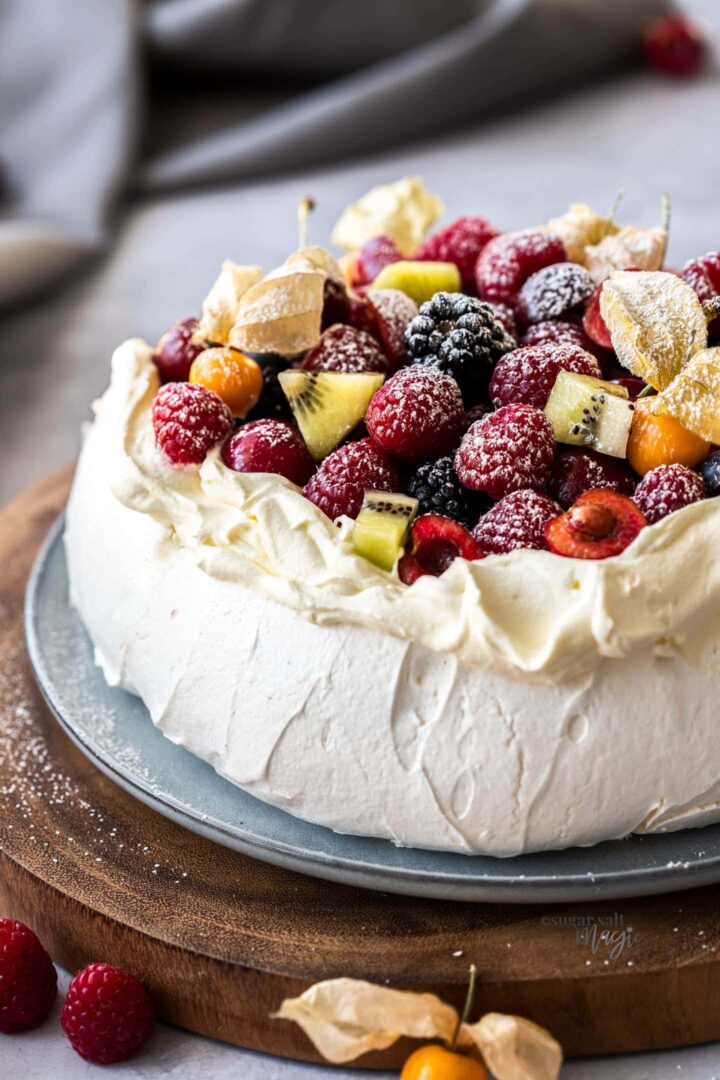
FEATURED COMMENT
I made this today and it really is the best pavlova I’ve ever made. I make them often and use a Mary Berry recipe which is lovely, but your recipe definitely wins. I topped it with fresh raspberries and passionfruit. Delicious.
Joanne Sykes
Heads up, this is a long post but don’t be overwhelmed. Some people find pavlova intimidating so I’ve added loads of tips and troubleshooting to this post so you can create a beautiful, show-stopping pavlova every single time. Below is a table of contents to get to where you need to go.
To skip all the tips, straight to the recipe, scroll back up to the top and hit the “↓ recipe” button.
Never Miss a Recipe!
Get the latest recipes straight to your inbox!
What is pavlova?
Pavlova is a combination of egg whites and sugar that are whipped to stiff peaks and then baked at a very low temperature, to create a meringue crust filled with a marshmallowy centre.
While the mixture is called meringue, Pavlova differs from meringue (as in meringue cookies) in that it has a soft, marshmallow-like centre (without the elasticity) rather than being crisp and dry all the way through.
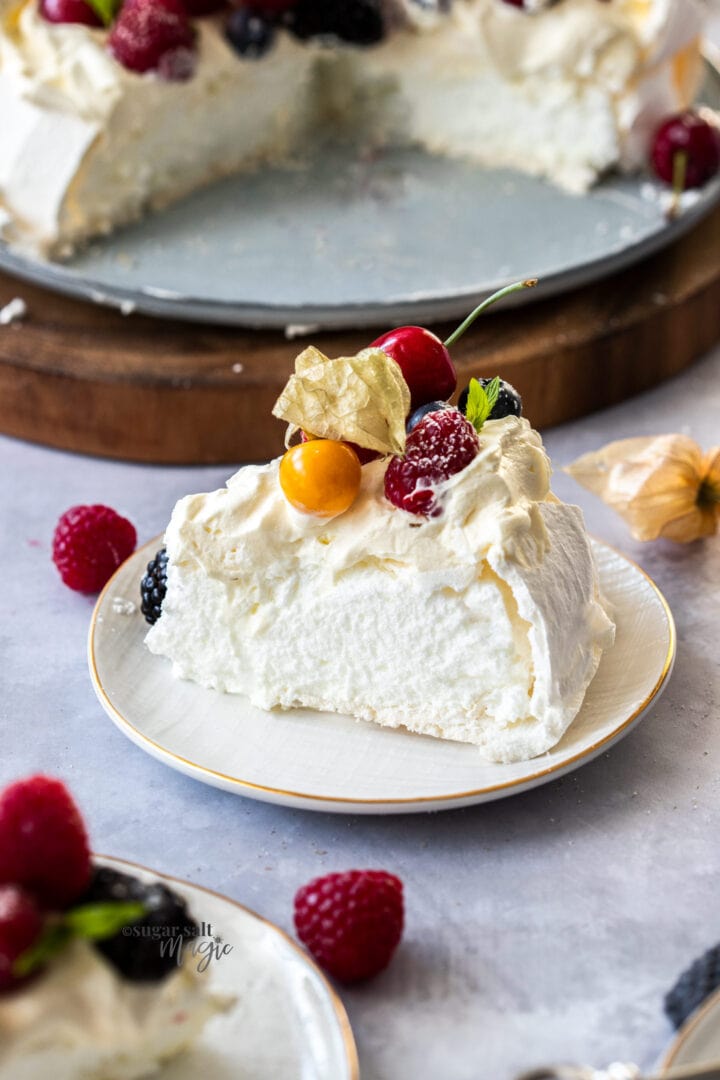
Where Does Pavlova Come From?
Both Australia and New Zealand claim this gorgeous dessert as their own. It was created in honour of the ballerina Anna Pavlova when she toured both countries in 1920’s. While I don’t expect the debate to stop here, the first reference to a pavlova in this form (large meringue topped with cream and fruit) is in an Australian article dating back to 1926.
My vote is clearly Aussie, however Kiwi’s and Aussie’s alike grew up with this beauty. Let’s just eat, not fight.
Ingredients
The best Pavlova is a very simple combination of 4 ingredients;
- Egg whites and sugar make up the base of a pavlova recipe and the combination is called meringue. The sugar dissolves into the glossy whipped egg whites to create sweet white clouds of meringue.
- Corn flour (cornstarch) is used to create the thick, melt-in-the-mouth marshmallow centre.
- Cream of tartar is used to stablise the egg whites. This can be swapped 1:1 for vinegar or lemon juice too.
You can also add a little vanilla extract and a pinch of salt (both at the end) if you like. I don’t think it needs either, so I stick with just 4 simple ingredients.
Make sure to use semi-fresh eggs, (so a little older than fresh but not old, if that makes sense) – cold or room temperature are both fine. Separate them using just your hands so you don’t accidentally break the yolk with the shell. Crack the egg open then tip it into one hand. Let the egg white run through your fingers into a small bowl. As long as no yolk got through, tip it into your measuring cup and repeat with the rest.
Use caster / superfine sugar. Not icing / powdered / confectioners sugar as they are not pure sugar. Also, don’t use white granulated sugar as it will take too long to dissolve into the egg whites, causing overbeaten eggs. Nor should you use brown sugars as they contain too much moisture which will lead to a weeping meringue. You can see more about the different types of sugar here.
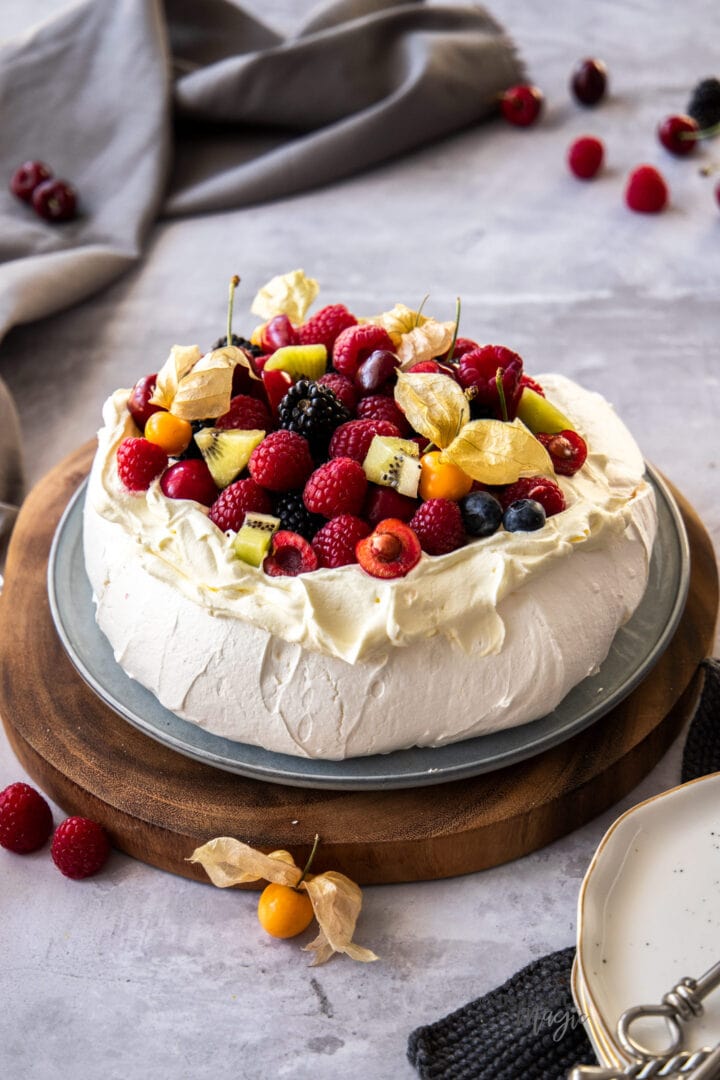
How To Make it (Step by Step)
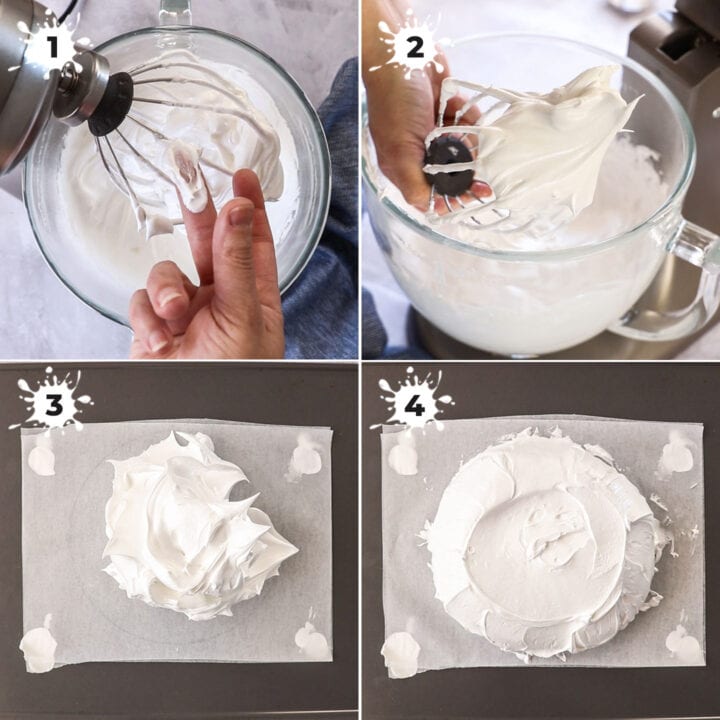
- Clean your equipment: The smallest bit of fat or grease can stop egg whites from whipping so begin by giving your equipment a fresh wash in hot soapy water, rinse, then dry well. I like to rub a slice of lemon over everything too as a final clean as it will remove any traces of fat.
- Measure your ingredients and, if scaling the recipe, stick to the right ratios of ¼ cup egg whites to ½ cup sugar to 1 teaspoon corn flour to ½ teaspoon cream of tartar.
- Egg sizes vary so much, so it’s best to use cup measurements to get the right amount. I use ¾ cup of egg whites in my recipe, which is equal to approximately 6 egg whites. This makes an 9 inch round pavlova about 3.5 inches high.
- Whip the egg whites to soft peaks before adding anything else. Use a whisk or whisk attachments with your stand mixer or hand beater.
- Add the sugar 1 spoon at a time. Count to 20 after each addition to give the last one a chance to dissolve into the egg whites. Counting just ensures you don’t rush this step.
- The meringue is ready when it is thick and voluminous. It should hold stiff peaks when you pull the beater out and when your rub a little between your fingertips it should be smooth and not gritty. If you still feel sugar granules, mix longer.
- Add the corn flour and cream of tartar (plus any extract) as the final mixing step.
- Prep your baking tray: Use a flat baking tray with no sides (this will make it easier to remove the pavlova once cool). Draw an 8 inch circle onto a piece of baking paper, then use dabs of meringue mixture on each corner to stick it to your tray. Cover it with another sheet of baking paper so you don’t get pen or pencil on your pavlova.
- When you transfer the meringue mixture to your tray, make sure not to bash the air out of the meringue. Treat it gently.
- Use a spatula to carefully shape the meringue to the circle guide line. Make sure it’s even thickness all over using sweeping motions. When you have a rough circle, use the same sweeping motions from the bottom up to the top around the sides. This will give you nice strong walls.
- Bake the pavlova in a preheated oven – 120C / 245F / 110C fan forced – for 90 minutes.
- After 90 minutes turn the oven off and leave the pavlova inside for at least 2 hours (you can even cook it in the evening and leave it in the oven overnight). This step will allow it to dry out further and cools it slowly to prevent cracking.
- Topping your pavlova – as tempting as it may be don’t overload your pavlova with toppings. The crust is very delicate and can crack under the weight of the toppings. Also, leave the decorating until the last minute if you can. This will also prevent cracking and stop the meringue from melting under the wet ingredients.
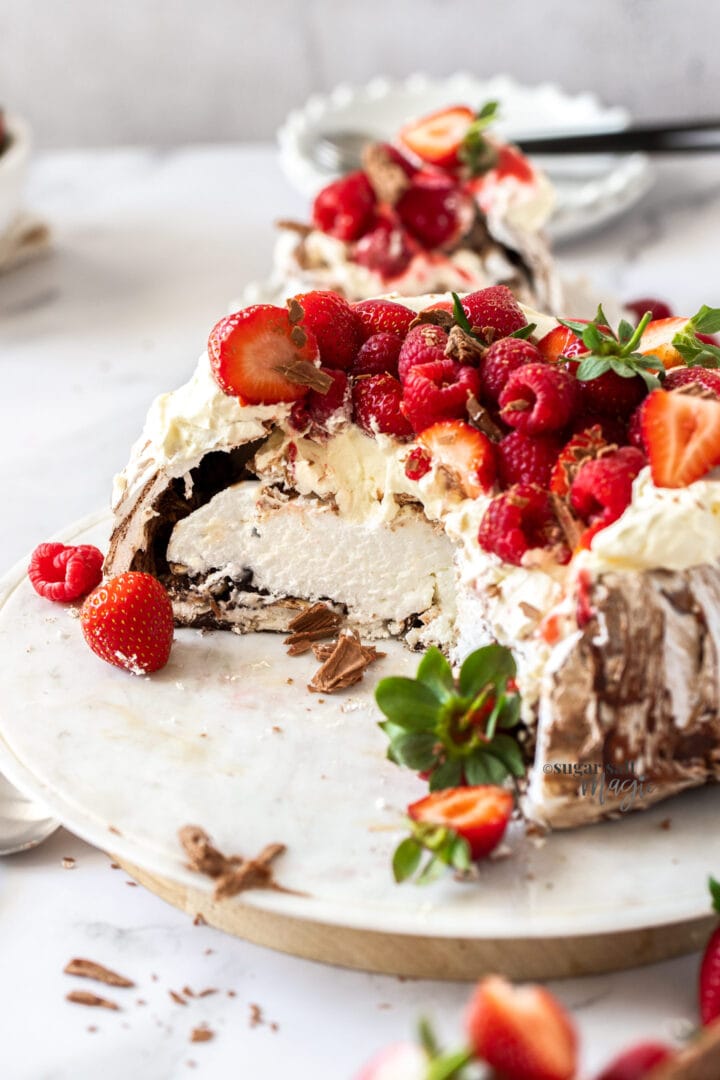
Leaving your pavlova in the oven for a few hours after you’ve turned it off, allows it to cool slowly and continue to dry out a little, at the same time. I love baking my pavlova the evening before an event and then leaving it in the oven overnight to cool.
Troubleshooting pavlova
My egg whites won’t whip
Solved: Egg whites won’t whip if they’ve come into contact with any fats.
For this reason, it’s very important to make sure your equipment is clean before you start and make sure you don’t get any yolk in the egg whites as you’re separating them.
Why is my pavlova flat?
Solved: Egg whites not whipped to stiff peaks or meringue deflated.
Whipping air into the egg whites is what will give it the ability to shape. Make sure you have stiff peaks before transferring the meringue mixture to the baking tray. If the air is knocked out of your meringue mixture before or while you’re shaping it, this can also cause the pavlova to flatten out.
Be gentle with it and if you add flavourings only mix for a few seconds as the moisture can begin to deflate the whipped egg whites.
Why did my Pavlova crack?
Solved: Rough handling, forgetting the acid, baking or cooling too quickly or overbeating the eggs can all cause cracking at the end.
Rough handling – Please keep in mind that one of the beautiful things about a pavlova is that they are delicate and light. They aren’t made to be feats of structural engineering like a decorated layer cake. Handle them with care and don’t overload the toppings.
I loaded the pavlova in these photos with fruit, more than I normally would and it did crack after the first few shots. That’s ok, it was still beautiful, it still had all the right textures and still tasted divine. Don’t let anyone tell you that a pavlova should not crack.
Forgetting the acid – cream of tartar, vinegar or lemon juice are used in pavlovas to add structure to the egg whites. They’ll help to stabilise the egg white which will in turn give it structure as it bakes.
Baked / cooled too quickly – don’t be tempted to turn the heat up to bake it quicker or remove it from the oven too quickly after it’s baked.
Overbeaten eggs – it is possible to overbeat the egg whites and this can happen before or after adding the sugar. Too prevent overbeating, keep an eye on the egg whites throughout. They should be beaten just until you have soft peaks before adding the sugar, then just until it hits stiff peak stage after adding the sugar. Use caster / superfine sugar which will dissolve more quickly. Also, you don’t need to use the highest setting to beat the egg whites. Go slower at the start, then turn it up to med-high after the sugar has been added.
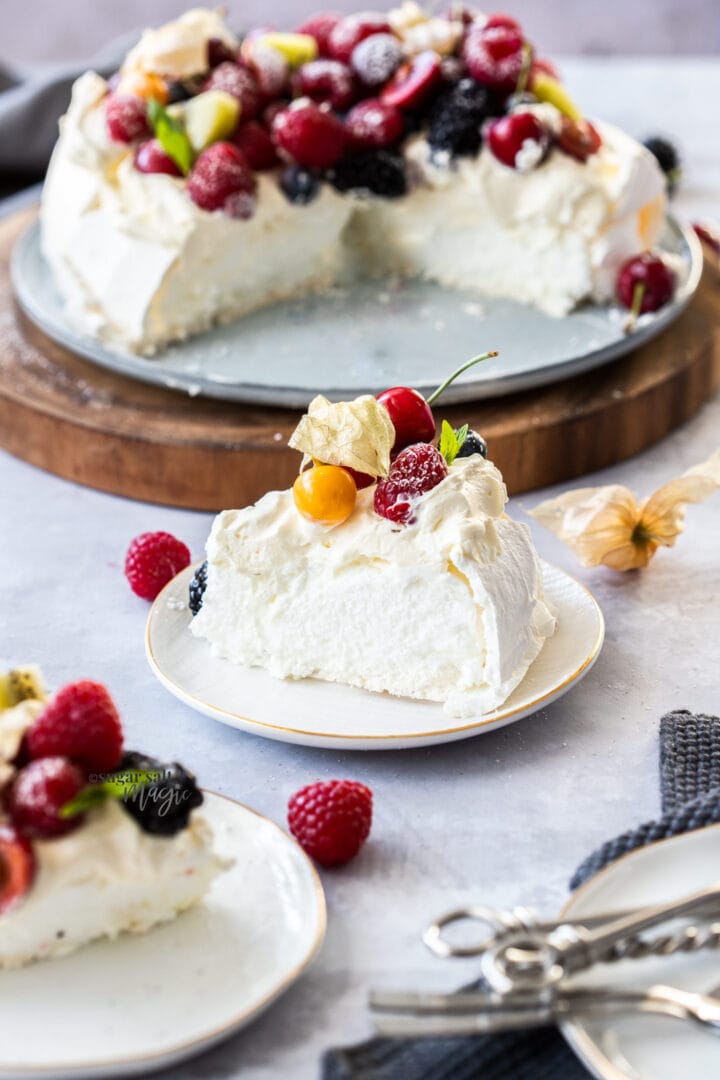
My pavlova is stuck to the paper / tin
Solved: Not baked through
If your pavlova is not baked for the set time or dried out long enough, the base will still have some moisture causing it to stick to the paper or tin. Make sure to bake for the required time and let it sit in the oven afterwards otherwise it may not be cooked through and trying to remove the paper may cause it to crack.
Why is my pavlova weeping?
Solved: Moisture or undissolved sugar
Moisture, including humidity in the air, can affect your pavlova. The sugar in the pavlova will draw in the moisture from the air, which in turn weeps out as the egg whites can’t hold it. In mild climates, you shouldn’t have an issue but in particularly humid climates
- try making it in the evening and letting it sit in the oven to dry out overnight.
- if you have refrigerated air conditioning cool the house down as much as you can before starting.
- don’t use the stove or anything that will create heat or steam in the kitchen prior to making your pavlova
Undissolved sugar can also cause weeping – use only caster or superfine sugar as it will dissolve more quickly. Always test your meringue mixture by rubbing a little between your thumb and forefinger. If it is no longer gritty, it’s ready to go.
My pavlova isn’t white
Solved: cooking at too high a temperature or added extracts are coloured.
All ovens vary, it’s a great idea to keep an oven thermometer in your oven at all times as thermostats can often be out of whack.
Don’t be tempted to bake it at a higher temperature to make it bake quicker. This can lead to browning or cracking. Browning of the pavlova is the sugar caramelising.
Coloured extracts – slight discolouring can also occur if you use an extract which is not clear but it should be very mild. I don’t think pavlova needs vanilla and in doing so, I keep it as white as possible. You can always add flavourings to your whipped cream instead.
Can Pavlova Be Made In Advance
Making pavlova the day (or night) before is best. Bake it before bed, then let it cool in the oven overnight in the oven with the door closed. It may last up to two days but as it will absorb moisture it will become less crisp the long time goes on. Also the more humid it is where you are, the more quickly it will lose crispness.
Store your pavlova, undecorated, in an airtight container in a cool, dry place. Don’t store it in the fridge.
Add cream and topping right before serving.
Can you freeze pavlova?
While not recommended, a pavlova base can be frozen. It should not be frozen with any toppings and I’ve had success with pavlova that’s been frozen no more than 2 weeks.
Make sure it’s completely cool and then place it on the baking tray straight into the freezer. Give it a couple of hours to get quite solid, then very carefully transfer it to a rigid, airtight container.
Thaw it for a couple of hours at room temperature. A frozen and thawed pavlova won’t be as good as fresh and the crust can sometimes not be quite as crisp.
How to decorate a pavlova
This simple answer to this is freshly whipped cream, followed by fresh fruit of whatever is in season. In Australia, Pavlova is regularly served during the summer, so fresh berries, mango or kiwi fruit are perfect.
Add pomegranate arils or passionfruit pulp for a drizzling of colour and interest. Curls or shavings of dark chocolate go lovely with strawberries and raspberries while toasted flakes of coconut and lime zest go beautifully with mango.
If you want to make a Christmas pavlova, why not add some cherries or cranberries, depending on where you are in the world.
Pavlova is an incredibly beautiful, light dessert and is perfect any time and now you have all the tips and tricks you need to make it perfectly every time.
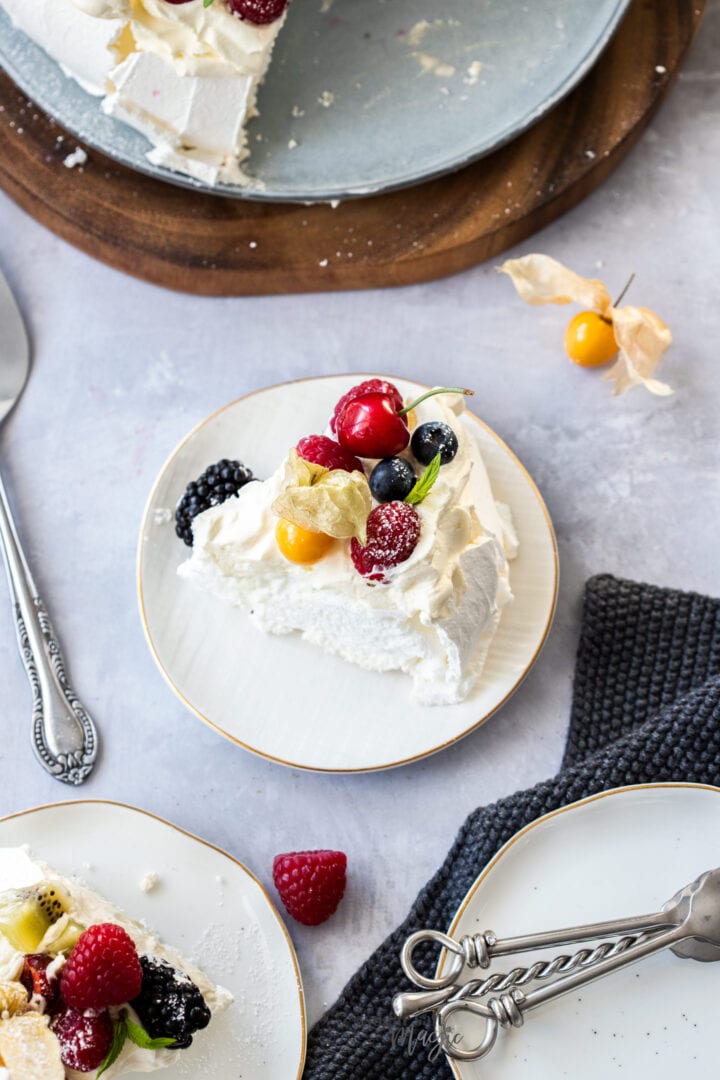
More recipes you’ll love
- Mini Pavlova Grazing Board
- Pavlova roll
- Mango pavlova
- Pavlova wreath
- Chocolate meringue cake
- Fluffy Vanilla Cake from Scratch
- Easy Peppermint Meringues
- Mini Lemon Meringue Pies
- Swirled Chocolate Meringues
- Raspberry Pavlova Ice Cream Cake
Did you try this pavlova recipe?
Leaving a rating and comment below the recipe is so helpful!
Hungry for more? Subscribe to the newsletter for free recipes straight to your inbox. Also, follow along on Facebook, Pinterest and Instagram.
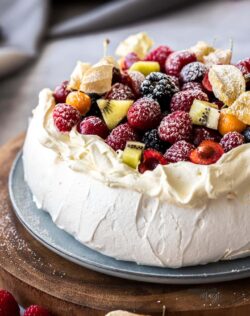
Video
Ingredients
- ¾ cup egg whites (approximately 6 large eggs), room temp (175g/6.2oz)
- 1 ½ cups caster (superfine) sugar (300g / 10.5oz) (notes)
- 3 teaspoons corn flour (cornstarch)
- 1 ½ teaspoons cream of tartar (notes)
- ¾ cup whipping (heavy) cream
- 1 cup mixed fresh fruit (notes)
For best results, always weigh ingredients where a weight is provided
Equipment
- Flat cookie trays
- stand mixer with whisk attachment or handheld beater
Instructions
- Preheat oven to 120C / 245F / 110C fan forced. Trace around an 8 inch cake tin with pencil onto a sheet of baking paper. Place another sheet on top and set aside.
- In a stand mixer, with the whisk attachment (or using a handheld beater), beat the egg whites on low-medium to soft peak stage. About 5 minutes.
- Add the sugar one tablespoon at a time, counting to 20 between each. Once all the sugar is all added, increase the speed to medium-high (not highest setting) and continue to whisk until the egg whites are thick and glossy and at stiff peak stage. Test the mixture by rubbing a little between your finger and thumb. It should be smooth. If it is still grainy, keep beating until it is smooth when you test it.
- Sift over the corn flour and cream of tartar and whisk for a few seconds, just long enough to incorporate it in.
- Take the sheet of baking paper with the circle on it and dot little bits of meringue under the corners and press it down onto the tray. Do the same with the second sheet and place that on top.
- Use a spatula to spoon the mixture onto the prepared baking tray and gently coax it into the shape of a circle using the drawn line as a guide. Now make small sweeps from the bottom to the top all the way round and finally level the top out.
- Place in the oven and bake for 1 ½ hours then turn the heat off and leave the pavlova in the oven, undisturbed, for at least 2 hours (notes).
- Once cool, top the pavlova with whipped cream and fresh fruit.
- Please take a moment to leave a comment & rating. It's appreciated and so helpful.
Notes
- All ovens vary – if you notice it turning golden, the oven may be too hot, turn it down.
- Don’t use icing, powdered, granulated or brown sugar. Only caster / superfine so that it dissolves without overbeating the egg whites.
- Cream of tartar can be swapped 1:1 for vinegar or lemon juice.
- For topping ideas, use whatever fruit is in season. Strawberries, kiwi fruit, passionfruit, mango, raspberries are all classic but you could also use blueberries, blackberries, lemon or lime zest, slices citrus fruits.
- You can bake your pavlova in the evening and leave it in the turned off oven overnight to cool.
- Check out all the tips, tricks and troubleshooting in the post.
IN THE POST
Links will take you to the post – just scroll down to the bottom to get back to the recipe card.MORE AUSSIE DESSERTS!
This post may contain affiliate links that earn me a small commission for my referral, at no extra cost to you. Thank you for supporting Sugar Salt Magic.

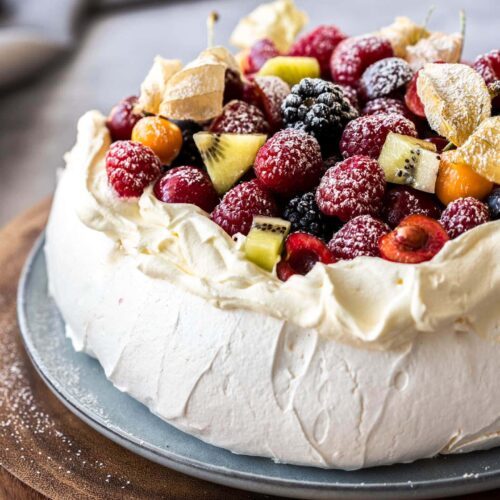
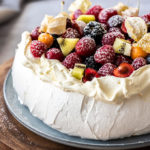

57 Comments on “How To Make Perfect Pavlova”
Easy recipe to follow. Looks beautiful….no weeping, no sticking, just lovely. No verdict until after tonight’s birthday party. Thanks for walking me through this one. Looks way more elegant than the time I’ve expended. Thanks.
So happy you love it, Elaine.
Suggestion: trace the circle on a sheet of parchment paper – then simply flip it over!
Yes, you can do that. The reason I use two sheets is because my baking sheet is very dark and it’s hard to see the line, using a second sheet makes it more visible 🙂
Looking forward to making this. Your instructions are clear and thorough to help me make a success ❤️
So happy it’s helpful Kristyn.
This was a great recipe. I wasn’t sure how pavlova differed from making any standard meringue so appreciated the tips, and the suggestions on decorating. It turned out great
So happy it was helpful, Louise 🙂
You never said she to add the cream.
Ruined the recipe
Hi Scott. I assume you missed step 8, where I say to top it with whipped cream and fresh fruit?
Hi I made your six egg pav, found the instructions easy, followed them carefully, however this recipe like all the previous I have tried resulted in an amazing looking pav but it weeps so much it ends up on a pool of clear syrupy fluid. So disappointing. Help!
Hi Christine. Pavlova weeping is caused most often by the sugar not being fully dissolved in the pavlova. It could also be caused by humidity. Is it hot and humid or is it rainy where you are?
So easy to make following the recipe. Never fails.
Love it as does the family
I’m so happy you love it, Kylie.
It’s straightforward enough and everything worked pretty well (first effort). My whites didn’t get to stiff peaks but the texture and taste are fantastic. One problem I had – it went kind of flat on me. I couldn’t get those beautiful sides.
Hi Bet. So happy you enjoyed it. You really need to get stiff peaks for a pavlova to hold it’s shape. Sometimes if the sugar is added a little too quickly it can stop it from getting nice and stiff. Also, cold eggs take longer than room temp eggs to get to stiff peaks but will hold their shape better.
If I were to weigh the egg whites and sugar , what would be the weights or ratio? Thanks
Hi Nat. You’re looking for about 175g / 6.2oz.
I’m panicking. Your recipe indicates using an 8 inch cake tin to create a stencil. But I’m noticing now that elsewhere on your page and in a comment you indicate that this recipe makes a 9 inch pavlova. My pavlova is already in the oven…. It looked great, but I’m worried about the bake time as it’s thicker, being only 8 inches wide. I’m intending to let this cool in the oven overnight. Will that be enough to adjust the bake time, or do I even need to worry about it?
No need to panic – I use an 8 inch tin for the guide line but it grows as it bakes so turns out about 9-9.5 inch once finished. But that’s only a guide because you may have made yours taller or wider when you shaped it. With pavlova, there is no real need to worry, they’ll bake beautifully whatever size but the guide I give is just so that you can create something similar to my pictures.
Thank you! That’s good to know. It makes me hopeful. I had an Aussie friend make pavlova for me as a child, but I’ve not had it for two decades and my kids are obsessed with Bluey and wanted to try it. I’ve never made any type of meringue before and your instructions were very helpful. Thank you!
This recipe is awesome !!! I tried 3 before this one and the others were flat. I used 6 egg whites and I think the key is adding sugar 1 tbsp at a time. I did not have cream of tartar so I used just over a tsp of white vinegar.
I can’t recommend this recipe enough and I am from New Zealand where this recipe was created :)))
I’m so so happy you love it, Victoria. It was all going so well until that last sentence haha! The debate will go on forever, I’m sure 🙂 Thanks so much for taking the time to leave a review.
It was incredibly good!!
I’m so happy to hear this, Patsy 🙂 Thank you so much for making my recipe.
Such a helpful post, thank you so much!
So happy it was helpful, Amélie.
Caster/superfine sugar is nowhere to be found where I live. Can I make it myself by putting the sugar in food processor? Do I adjust amount if I do this?
Hi Jean. Yes, you can process granulated sugar until it’s finer and use that. The amount should be roughly the same.
Thanks a lot for answering my message. Your step-by-step recipe is awesome! I love your Pavlova, I think it is the very best recipe! I’ve used different ones and this one is really good!
Now I need to make a bigger one, the size of a 10 inch cake tin. How can I adapt this recipe?
Thanks a lot!
Hi Patsy. When I bake this one it turns out about 9 inches, so there’s a couple of ways to do this. You can stick to the recipe and just spread it out a bit wider to begin with (it will end up just a little shorter in height once baked) or you could just add an extra egg white, and an extra 1/4 cup of sugar, and spread it out more. This will give you a similar depth but more meringue to spread out wider.
Hi! I’m a Pavlova fan and love your recipes. I have a doubt, though. In the recipe for “How to make perfect Pavlova” you talk about a pavlova with 6 eggs aprox + 120C or 110 C fan forced oven and baked for 1 1/2 hour BUT in the “Raspberry Pavlova Ice Cream Cake” where you use 4 egg whites, you suggest using oven to 120C / 100C fan forced and to bake it for 2 hours.
Can you help me here, please. Thanks
Hi Patsy, The pavlova on the ice cream is baked slightly differently, being in a springform tin that you later need to release it from whilst the other is open to the air flowing around it and it was made a little firmer as it is sitting on top of ice cream.
What should I do to prevent my pav sinking in the middle
It looked great but the center has sunk
Hi Jacky, can you clarify what you mean by sunk. Has the top cracked and fallen in? The marshmallow is not meant to fill the whole cavity and you will need to be gentle with a pav so that it doesn’t crack and the top fall in.
I was hoping to see a recipe/instructions that uses less eggs (3-4 would be good). What needs adjusting in order to get a thicker crust? Is it the cooking time?
Hi Troy, you can certainly reduce the egg whites, just use 1/4 cup of sugar per egg white. I wouldn’t adjust anything else, though you won’t need to cook it as long as it will make a much smaller pavlova.
Hi,
Im in the process of making this pavlova now for Christmas. Just wondering if you can overwhip it? I may have added sugar slightly too early and am overcompensating now to get it to the right texture. Will help with future attempts – Thanks!
Yes, you can but what I’d suggest if you’re worried you’ve added the sugar too early just whip it on a slightly lower setting. It should still be gone though
Very good recipe and very clear too
Thanks Ailing. So happy you love it
Could you give me an idea of time in oven if I do small individual ones.
Thank you
Hi Debbie, it will depend on the size / thickness and how much of a soft centre you’d like. For these Swirled Chocolate Meringues, which are about the size of your fist, I cook them for about 1 hour in a warmer oven resulting in just a slightly chewy centre. I’d suggest 45 minutes for something a little softer of the same size.
Surely we are supposed to add sugar to the heavy whipping cream, right? I didn’t see that mentioned, nor the quantity of sugar to use.
Hi Linda, no sugar in the whipping cream. It’s not needed since meringue is already very sweet
I made this today and it really is the best pavlova I’ve ever made. I make them often and use a Mary Berry recipe which is lovely, but your recipe definitely wins. I topped it with fresh raspberries and passionfruit.
Delicious.
Joanne, you just absolutely made my day. Thanks so much for your support
Hello – This looks fabulous and I am making it today! Just a quick question about the sugar however. I do not have castor sugar but am a bit confused about not using confectioners sugar (which is just superfine sugar and corn starch), since the starch is added anyway.
I am going to try blending regular sugar to get a finer consistency and then add the starch as you suggested but I am asking for the next time 🙂
Hello Andrea, such a brilliant question. Powdered sugar will require much more in the recipe since it’s weight is much lighter than granulated or superfine. Also the amount of starch in powdered sugars differs and it can cause your meringue to become too dry. Best to use caster / superfine. You can use granulated but it will take longer to dissolve and you risk overbeating the egg whites. Huge pat on the back to you for taking the time to blend your sugar to a finer consistency.
Hi,thanks so much for all the details to make a beautiful pavlova. I have a question if you can help me. How much can I reduce the quantity of sugar used in a pavlova? Thanks again and have great day 😊
Hi Vanessa, a pavlova is mainly egg whites and sugar and both are required to get the structure so unfortunately this is not really a dessert where you can alter the ratios. It’s possible some sugar alternatives (like monkfruit sweetener) may work but I’ve not tested so I couldn’t guarantee the results.
Made this pavlova just turn out beautiful I have another recipe but decided to make this one. Turn out perfect
Thank you so much Tita, you made my day. I’m so happy you enjoyed it 🙂
Fabulous post Marie. Thank you.
Aussie Aussie Aussie oi oi oi ! Sorry couldn’t resist.
haha. thanks so much Pamela 🙂
Gorgeous photos! And I love the post, so many great tips and info here!
Thanks Trang 🙂